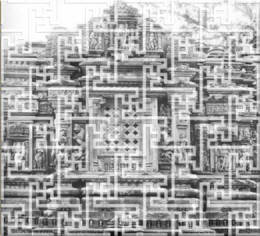The Sentients (Jiva)

Occupied space (loka-akasa) contains an infinite number of immaterial souls (jiva). Unlike atoms (pudgala) these souls do not lack dimension; each has an uncountable (asamkhyata) number of space-points (pradesa) and exists within the physical limits of its current corporeal shape, just as a lamp illuminates only the room in which it stands. This adaptation to a particular body's dimensions, however, is said to involve no change in the nature of the soul; whether a given body is as large as the entire loka-akasa or as small as the tiniest object imaginable the number of the soul's space-points remains the same. As noted earlier, this phenomenon is compared to the case of a cloth, which can be folded into various shapes without any alteration of its mass.
Orthodox Indian systems (darsanas) have generally described the soul either as omnipresent (vibhu) or as atomic (anu); but both descriptions stress the absolute unchangeability of this most important of all existents. While Jaina soul-theory per se does not fall easily into a general "heterodox" category (it accepts, for example, the kind of karmic ally generated retribution and bondage rejected by the Carvaka materialists and also contradicts Buddhist views by postulating a real substance beyond momentary modes, it is nevertheless true that the Jaina suggestion - indeed requirement - of some form of change in the soul-substance constitutes a unique and significant departure from the mainstream of Indian thought. The sort of dimensional change of this position, as closer examination of Jaina statements about the jiva will show,
First of all, a Jaina regards the existence of a bound and changeable soul as self-evident; such a soul is the reality without which his entire world-view and quest for salvation would be meaningless.
External demonstrations or proofs for this reality are considered redundant and superfluous the simple experience of self-awareness (ahampra-tyaya) is proof enough.
Even doubt - for example, "is there really a self here?" - supports this view when one asks the further question, "who is it that has the doubt?"
The answer given, of course, is jiva, the basic "I" that stands behind all human actions.
A soul is said to have three main qualities (guna) or functional aspects: consciousness (caitanya), bliss (sukha), and energy (virya). Of these, consciousness is central, representing what is in effect the distinguishing characteristic of the soul.
It is through operation of this quality that a soul can be the knower (pramiitr), that which illuminates both objects and itself.
The application of consciousness is referred to as cognition (upayoga), which is twofold:
- perception (darsana),
that is, first contact, indistinct awareness, or what might be called pure apprehension; and - knowledge (jnana),
that is, comprehending the details of what has been perceived.
Since in the mundane state darsana and jnana invariably operate in sequence, and are affected by different types of karmas, they are generally considered to be two distinct qualities (gunas) of the soul rather than aspects of a single quality. In spite of certain controversies over this distinction, it will hereafter be employed with reference to the soul's cognitive functions.
That is, reference will be made to both "perception" and "knowledge," rather than simply to "consciousness."
The next important quality of the soul is bliss (sukha), which can be experienced by the jiva through self-knowledge.
This quality is said to be fully manifest only when the soul attains perfect purity; the extent to which it is experienced corresponds directly to the degree of that purity.
Strictly speaking, "pure bliss" is simply a label for the perfected, self-contained (svabhava-sthita) state of the soul,
| For a study of the contrast between the quality of bliss (sukha) and the ordinary.'feeling of happiness" (sukha vedana), see P.S. Jaini 1977b |
Although such desire is described as antithetical to bliss, it must be understood that these two are not mutually opposed entities; they are, rather, two ends of the same continuum, the defiled (vibhava) and purified (svabhava) states of the same quality.
This is considered analogous to the case of water, which is cool by nature but becomes hot in the presence of fire. Taking coolness as the normal or "pure" state of water, hotness becomes an unnatural or "defiled" condition, reached in the presence of an outside agent. Similarly, the soul is by nature self-contained (uninterested in external things) and totally blissful; it becomes "desirous" through association with certain external factors called defiling karmas.
It is important to note here that bliss is the only quality of the soul, which can truly be defiled, that is, transformed into something of a different nature; other qualities can only be "obscured" or "blocked" (avrta) by so-called obscuring (avaraniya) karmas. (As will be seen below,
a direct relation obtains between the degree of obscuration and defilement.) Hence the expression "defiled soul" really refers specifically to change along the dimension of the bliss-quality.
Energy
Another significant quality of the soul is that called energy (virya). This functions as a sort of meta-quality, an abstract force which energizes, as it were, the very operation of the knowledge and perception qualities.
Thus, it will be said that both forms of cognition are manifested, at a given moment, in exact proportion to whatever percentage of the soul's infinite energy is present at that moment.
Limitations are imposed on the amount of available virya by the condition of embodiment itself. This karmically produced mundane state also channels or "perverts" the direct expression of energy, causing it to generate a certain movement or vibration (yoga) of the soul; such vibration draws new karmic matter into association with the soul substance. But Virya is also the efficient cause by which the soul brings about modifications in the functions of the karmic matter drawn towards the soul.
Finally, virya is conventionally understood as the soul's capacity to engage in so-called giving (dana), obtaining (labha), enjoyment (bhoga), and repeated enjoyment (upabhoga) of worldly objects.
A limited ability to take part in these activities during daily life is thought to be due to obstruction of virya by particular karmas.
Jainas speak of the "innumerable qualities" of the soul.
Nevertheless, it can legitimately be said that the presence of those qualities which have been briefly discussed above - perception, knowledge, bliss, and energy - are sufficient to define the soul as a totally distinct and unique entity, an existent separate from all other.
Thus, concludes this introduction to the basic units of the Jaina universe, the living and nonliving factors in terms of which all experience must be analyzed and all religious meaning found. To approach the integrated concept of reality into which the Jaina has molded these factors, we must now begin from the same starting point that he does: the fact of the soul's long and painful entrapment in the chains of bondage, chains forged as much by the souls' own potential for defilement as by the effects of material "karma".
 Padmanabh S. Jaini
Padmanabh S. Jaini


